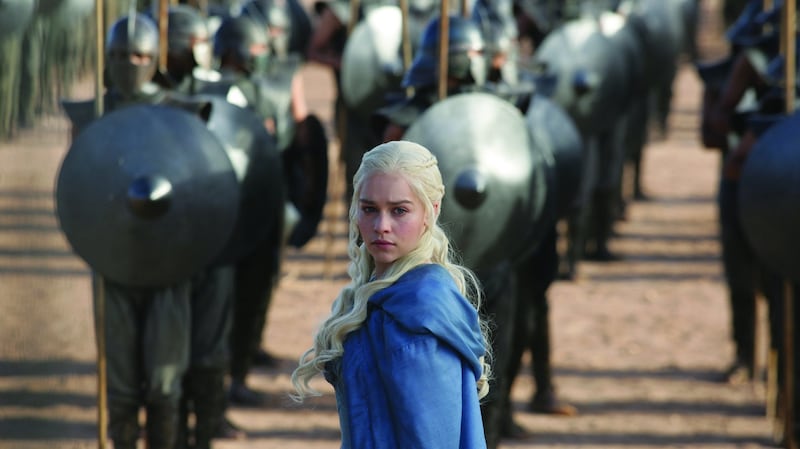When a three-time champion golfer describes a golf course as “unbelievable” it tends to make golf fans wherever they are in the world sit up and take notice.
And when that three-time champion golfer is Tiger Woods and he is talking about the Royal Portrush golf course, which hosted the 148th Open tournament in July, then it becomes an entirely different ball game for tourism in Northern Ireland.
According to the R&A, the organisers of the tournament, the 148th Open at Royal Portrush was the fastest selling event in the championship’s history, and attracted a record 237,000 spectators.
This influx of golf fans played a major part in making 2019, according to tourist chiefs, an “outstanding year for tourism” in the North.
John McGrillen, chief executive of Tourism NI, which markets the North to domestic tourists throughout the island, said the 148th Open was simply “a ground-breaking event for tourism in Northern Ireland”.
A recent report commissioned by the R&A shows that the Open delivered more than £100 million (€117 million) of “economic benefit” for the North this year.
The report, carried out by researchers at Sheffield Hallam University's sport industry research centre, highlights that the championship, which was won by Offaly's Shane Lowry, directly injected £45 million (€53 million) into the North's economy.
It also suggests that Northern Ireland has benefited from £37.3 million (€43.6 million) in destination marketing benefit from over 5,400 hours of global television coverage.
Mr McGrillen is hoping that the high praise from Woods and from many of the other 156 golfers, including Brooks Koepka and Jordan Spieth, will inspire golf fans from across the world to add Royal Portrush to their must-play bucket lists.
At the very least he believes that the 148th Open will have a lasting, positive impact on the North’s economy.
“I do believe that this will help grow our golf tourism because of how Northern Ireland was portrayed successfully across the globe – 50 per cent of all of the spectators who came to the Open were from outside Northern Ireland and we will build on that success.
“Overall it has been an outstanding year for tourism in Northern Ireland, and the Open at Royal Portrush played a key role in growing tourism numbers and revenue.”
Local economy
Mr McGrillen said despite the fact that 2019 was a challenging year both from an economic and political perspective, latest figures suggest that tourism contributed £2.7 million (€3.1 million) a day to the local economy.
“We went into 2019 against the backdrop of Brexit and a high degree of uncertainty, but we have achieved growth right across the tourism industry despite this.
“Brexit has had an impact in different ways because of the continuing uncertainty – for example, there was a fall-off in bookings specifically around the first October 31st deadline for the UK to leave the EU, but then bookings improved again after that.
“Now that the position has been clarified we have to ensure that Northern Ireland is seen as a welcoming place for everyone, specifically the Republic of Ireland market which is on our doorstep and which I believe is one of our largest untapped markets.”
Although Brexit may have deterred some people from making travel plans during the year there was one army of fans who were not put off from visiting the North as their favourite hit television show officially drew to a close.

The eighth and final series of HBO’s award-winning Game of Thrones (GoT), which was shot across various locations in the North, was screened across the world in April and May.
Since it first aired in 2011, fans of the show have flocked to the North to walk in the footsteps of the many heroes and villains from the fantasy show and see for themselves some of the 26 publicly accessible Game of Thrones film locations.
Tourism NI estimates that one in every six international leisure visitors that currently chooses to travel to the North does so because of Game of Thrones.
Mr McGrillen said: “Because of GoT 350,000 people now visit Northern Ireland each year and spend more than £50 million. So that continues to be one of our biggest success stories, and next year the first of our GoT legacy projects will open which I believe will give GoT fans a new reason to come to Northern Ireland.”
The first legacy project will be based around a studio tour of Linen Mill Studios near Banbridge, Co Down, one of the original filming locations, and will feature original set-pieces, costumes, props and weapons.
Screen tourists
But Game of Thrones fans have not been the only screen tourists that the North has welcomed this year. Thanks to the success of Channel 4’s Derry Girls, which tells the story of 16-year-old Erin and her school friends and family during the Troubles, the city of Derry is enjoying a new starring role as a film location.
Not only can fans of the show enjoy a selfie with the massive Derry Girls mural on the side of the Badger’s Bar and restaurant in the city, but there are growing numbers of Derry Girls’ experiences from walking tours featuring some of the most popular locations on the show, restaurants and hotels offering themed dishes and packages, and a brewery that has developed Derry Girls craft beers.

This surge in screen tourism is one of the reasons why there has been a major expansion of the hotel sector in the North over the last three years. In 2018 more than 1,000 new rooms were available and the investment in the hotel sector continues with the Haslem, Lisburn’s first hotel, scheduled to open in spring next year.
Yet while Tourism NI is upbeat about the industry's performance during the last 12 month, it appears that it may not have quite matched up to the ambitious targets set by Tourism Ireland, the umbrella agency which markets the island of Ireland overseas as a holiday and business tourism destination.
Tourism Ireland is one of the “six areas of co-operation” established under the Belfast Agreement.
During the year Tourism Ireland had to refute claims by the DUP's Ian Paisley that "there is a view" that it "really first and foremost has to promote the Republic of Ireland, and that Northern Ireland gets second place in that".
Niall Gibbons, chief executive of Tourism Ireland, told Mr Paisley that this "view" was not correct, and that the organisation "makes sure that we give a lot of prominence to Northern Ireland".
According to Mr Gibbons, since 2002 Tourism Ireland has helped to attract 30 million overseas visitors to Northern Ireland, which has in turn generated £6.6 billion (€7.7 billion) for the North’s economy.
Numbers
Latest preliminary figures for 2019 for the cross-Border agency suggest that an estimated 2.265 million overseas tourists travelled to Northern Ireland this year. This is slightly behind Tourism Ireland’s hoped-for results for the year – in 2018 Tourism Ireland had outlined that it aimed to grow overseas visitor numbers to the North to more than 2.33 million in 2019.
Tourism Ireland had also said that it aimed to increase overseas tourism revenue by 8 per cent to £639 million (€748 million) for the North’s economy during 2019. Although tourism revenue did increase in the North throughout the year, Tourism Ireland estimates that it is likely to be in the region of £570 million (€667 million) for the full year, somewhat short of its desired £639 million (€748 million).
According to Mr Gibbons the organisation “pulled out all the stops” during 2019 to capitalise on the global interest in the final series of Game of Thrones and in the Open at Royal Portrush.
“Thousands of opportunities were created for potential visitors around the world to read, hear or watch positive messages about Northern Ireland; Tourism Ireland estimates that this media exposure is worth an estimated £157 million in equivalent advertising value,” he said.
According to Tourism Ireland it plans to build on the "legacy" of the 148th Open and the North's Game of Thrones association with a new three-year "flexible and sustainable" marketing strategy entitled Northern Ireland – Embrace a Giant Spirit.
Its “aim” is to grow overseas visitor numbers to the North by 13 per cent to 2.57 million and overseas tourism revenue by 15 per cent to £658 million (€770 million) by 2022.






